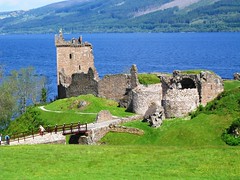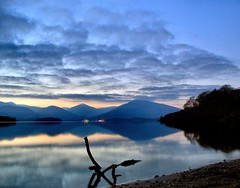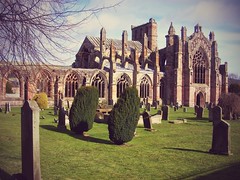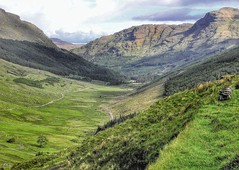The travel and living abroad section of the Foreign and Commonwealth Office website is designed to help British travellers have a safe and hassle free trip with helpful advice and tips. The website provides country specific advice by providing up-to-date information on entry requirements, threats to personal safety and natural disasters. The public can also obtain travel advice by telephoning, writing to the above address or by email.
Continue Reading
Print
Email
Wildlife watching in Scotland
Hillwalking & Climbing in Scotland | Cycling | Skiing | Surfing | Fishing | Golf | Wildlife Watching in Scotland | Outdoor Activities | Best Wildlife Watching Locations
Almost anywhere around the northern coasts of Scotland there is a chance to see dolphins and occasionally porpoises, seals and whales. The most popular place to see dolphins is in the Moray Firth area which has a resident population of about 150, most frequently seen in the summer months. Other good places to catch glimpses of the creatures are at the entrance to the Caledonian Canal at Inverness, Nairn beach, Arderseir, Fort George, Fortrose and Cromarty. Seals can be seen in abundance. They can often be observed lolling about on sandbanks when the tide is out, and there are plenty of seal-spotting boat trips on offer from spring to autumn.
Otters are more elusive. They tend to live on undisturbed remote stretches of the seashore or quiet areas of a river. If you are determined to spot the creatures, for further information contact Skye Environmental Centre (home to the International Otter Survival Fund), Tel. 01471-822487. Whales, Minke and Orcas, inhabit the Atlantic, Pentland Firth and the Moray Firth. Contact the Highlands of Scotland Tourist Board, Tel. 0870-5143070, Higlands of Scotland Tourist Board for details of boat trips.
Birdwatching
Scotland is great for birdwatching. Over 450 species have been recorded, including vast colonies of seabirds, birds of prey and many rare species. Among the best places in Scotland to see birds are Handa Island off the coast of Sutherland, and the Treshnish Islands, off Mull, where you'll see colonies of shags, razorbills, guillemots and puffins. Details of how to get there are given in the relevant sections.
Other excellent places for birdwatching include Caerlaverock near Dumfries, the Isle of May off the coast of Fife, the Bass Rock off North Berwick, Fowlsheugh near Stonehaven, and Loch Garten by Boat of Garten, where you can see ospreys. Many of the Hebridean islands, such as Islay and Mull, are home to a rich variety of seabirds and you can also see golden eagles.
Orkney and Shetland are famous for their rich variety of birdlife and are home to large colonies of seabirds and migratory birds. There are puffins, kittiwakes, fulmars, shags, razorbills, guillemots and even auks.
Useful organizations
Further information can be obtained from the Royal Society for the Protection of Birds, 17 Regent Terr, Edinburgh EH7 5BT, Tel. 0131-5573136; the Scottish Ornithologists Club, 21 Regent Terr, Edinburgh EH7 5BT, Tel. 0131-5566042; and the Scottish Wildlife Trust, Cramond House, Cramond Glebe Road, Edinburgh EH4 6NS, Tel. 0131-3127765, which owns and runs over 100 nature reserves.
Print
Email
Arriving in Scotland
Tourist Information | Customs Information | Health & Safety
Tourist information
Tourist offices – called Tourist Information Centres (TICs) – can be found in most Scottish towns. Their addresses, phone numbers and opening hours are listed in the relevant sections of this book. Opening hours vary depending on the time of year, and many of the smaller offices are closed during the winter months. All tourist offices provide information on accommodation, public transport, local attractions and restaurants, as well as selling books, local guides, maps and souvenirs. Many also have free street plans and leaflets describing local walks. They can also book accommodation for you for a small fee.
Museums, galleries & monuments
Most of Scotland’s tourist attractions, apart from the large museums and art galleries in the main cities, are open only from Easter to October. Full details of opening hours, sights>opening hours and admission charges, sights>admission charges are given in the relevant sections of this guide.
Over 100 of the country’s most prestigious sights, and 185,000 acres of beautiful countryside, are cared for by the National Trust for Scotland (NTS), 26-31 Charlotte Square, Edinburgh EH2 4ET, Tel: 0131-2439300, www.nts.org.uk National Trust properties are indicated in this guide as ‘NTS’, and entry charges and opening hours are given for each property. If you’re going to be visiting several sights during your stay, then it’s worth taking annual membership. This costs £28, £12 if you’re aged under 26 and £47 for a family, and gives free access to all NTS and NT properties. The National Trust Touring Pass costs £18 per adult and £28 for a family, and gives free admission to its properties for seven days. A 14-day pass costs £26 and £44 respectively. YHA and HI members and student-card holders get 50% discount on NTS admission charges.
Historic Scotland (HS), Longmore House, Salisbury Place, Edinburgh EH9 1SH, Tel: 0131-6688800, www.historic-scotland.gov.uk, manages more than 330 of Scotland’s most important castles, monuments and other historic sites. Historic Scotland properties are indicated as ‘HS’, and admission charges and opening hours are also given in this guide. Historic Scotland offer an Explorer Ticket which allows free entry to 70 of their properties including Edinburgh and Stirling castles. It costs £17 per adult and £35 for a family for seven days, and £22/£42 for 14 days. It can save a lot of money, as entry to Edinburgh Castle alone is £7.50 per adult.
Many other historic buildings are owned by local authorities, and admission is cheap, or in many cases free. Most municipal art galleries museums are free, as well as most state-owned museums, including those in Edinburgh and Glasgow. Most fee-paying attractions give a discount or concession for senior citizens, the unemployed, full-time students and children under 16 (those under five are admitted free everywhere). Proof of age or status must be shown. Many of Scotland’s stately homes are still owned and occupied by the landed gentry, and admission charges are usually between £4 and £6.
Print
Email
Niche Travel Interests
Hillwalking & Climbing in Scotland | Cycling | Skiing | Surfing | Fishing | Golf | Wildlife Watching in Scotland | Outdoor Activities | Best Wildlife Watching Locations
Scotland is a great country for outdoor activities and many visitors come specifically to enjoy the magnificent scenery as they walk in the hills, cycle through forests, ski down mountains or head off in search of rare wildlife. The coastline, lochs and rivers are ideal for fishing and offer plenty of opportunities for a whole range of watersports, including windsurfing, sailing and scuba diving, and there are lots of beautiful beaches, especially on the northwest coast and the islands.
Print
Email
Skiing
Hillwalking & Climbing in Scotland | Cycling | Skiing | Surfing | Fishing | Golf | Wildlife Watching in Scotland | Outdoor Activities | Best Wildlife Watching Locations
Holiday Cottages Near Ski Resorts in Scotland
Conditions in Scotland are not as good or reliable as anywhere in the Alps, but on a clear, sunny day, and with good snow, you can enjoy some decent skiing. However, at weekends, in conditions like these, expect the slopes to be very busy. Scotland offers both alpine (downhill) and nordic (cross-country) skiing, as well as the increasingly popular snowboarding. The high season is from January to April, but it is possible to ski from as early as November to as late as May. Ski packages are available, but it's easy to arrange everything yourself and there's plentiful accommodation and facilities in and around the ski centres.
There are five ski centres in Scotland. The largest are Glenshee, which has the most extensive network of lifts and selection of runs, as well as snow machines, and Cairngorm, which has almost 30 runs spread over an extensive area. Glencoe is the oldest of the ski resorts, and the Nevis Range, at Aonach Mor near Fort William, has the highest ski runs and only gondola in Scotland, as well as a dry slope. The Lecht is the most remote centre, and is good for beginners and families and for nordic skiing. Access to all five centres is easiest by car. Each resort has a ski patrol and facilities for snowboarding.
Costs
Ski equipment and clothing can be hired at all resorts, but lessons should be booked in advance. Prices vary from centre to centre, but on average expect to pay around £13 per day for hire of skis, sticks and boots, and around £12 per day for ski clothes. Snowboard hire is around £16-17 per day for board and boots. Lift passes cost around £18-20 per day, or £68-80 for five days. Ski lessons are around £18 for four hours. Packages including ski hire, tuition and lift pass cost from around £125 to £155 for five days. These prices are for adults; prices for juniors are less.
Information
Details for each of the five resorts, including phone numbers, are given in the appropriate place in the main text. For further general information contact the Scottish Tourist Board for its Ski Scotland brochure and accommodation list, or visit their website, Ski Scotland which is updated daily. Or you can contact the Scottish National Ski Council, Tel. 0131-3177280, Scottish National Ski Council They produce a useful Snowsport Scotland Handbook.
The Ski hotline weather-report service gives the latest snow and weather conditions plus a five-day forecast. Phone: Tel. 0891-654 followed by: 655 for Cairngorm; 656 for Glenshee; 657 for The Lecht; 658 for Glencoe; 660 for Nevis Range; and 659 for cross country skiing.
Print
Email
Introduction to Shopping Scotland
The shelves of gift shops in every tourist attraction from John O' Groats to Jedburgh are stuffed full of dreadful tartan tat such as 'See-you-Jimmy' wigs and bonnets, Loch Ness monster replicas and those scary-looking tartan dolls with flickering eyelashes. All very harmless (except for the dolls which give you nightmares), but not doing much for Scotland's image. But amongst all this tourist kitsch are many excellent high-quality goods on offer.
Scottish textiles, especially the tartan variety, are popular and worth buying. Everything from a travelling rug to your own kilt outfit. Shops up and down the country, and especially in Edinburgh and Inverness, can tell which clan your family belongs to and make you a kilt in that particular tartan. For the full outfit, including kilt, sporran, jacket, shoes and skeann dhu dagger, expect to pay in the region of £600, or more if you want more elaborate accessories.
There are mill shops making tweeds and cloths in many parts of Scotland. Most are in the Borders, though it is not necessarily cheaper to buy at source. Harris Tweed is also a good buy and you can watch your cloth being woven on the Hebridean islands of Harris and Lewis.
Knitwear is also good value and sold throughout Scotland, though the cashmere industry in the Borders is suffering from high trade tariffs. Shetland is a good place to find high-quality wool products. Note that Aran jumpers are not from the island of Arran, but from Aran (with one 'r') in Ireland.
Jewellery is another popular souvenir and there are many excellent craft shops throughout the Highlands and Islands making beautiful jewellery with Celtic designs. Glassware is also popular, particularly Edinburgh crystal and Caithness glass, as well as pottery.
Food is another good souvenir and not just the ubiquitous shortbread sold in tartan tins. If you haven't far to travel home, smoked salmon, or any other smoked product, is good value. One of the best places for food products is the island of Arran, where you can buy their delicious local mustards and preserves, smoked fish and game, and cheeses.
And, of course, there's whisky. Most distilleries will refund the cost of their guided tour in the form of a discount voucher on a bottle of their brand whisky.
Before You Travel | Money | Getting to Scotland | Arriving in Scotland | Where To Stay | Getting Around | Keeping in Touch | Food & Drink in Scotland | Shopping in Scotland | Entertainment & Nightlife in Scotland | Holidays & Events | Special Interest Travel | Tours | Munros Climbing Guide
Shopping hours
Shop opening hours in Scotland are generally Monday to Saturday from 0900-1730 or 1800. In larger towns and cities, many shops also open on Sundays and late at night, usually on a Thursday and Friday. Large supermarkets and retail complexes found outside large towns are open till 2000 or later Monday-Saturday and till 1600 on Sunday. In the Highlands and Islands, few shops are open on Sunday, most notably in the Outer Hebrides where nothing is open on a Sunday. Also note that in many rural areas there is an early-closing day when shops close at 1300. This varies from region to region, but the most common day is Wednesday.
Print
Email
Pubs and bars
Spectator Sports in Scotland | Cultural Events in Scotland | Pubs and Bars in Scotland
As in the rest of Britain, pubs are the main focus of social life and entertainment for most Scots. These vary greatly, from traditional old inns full of character (and often full of characters) to chic and trendy bars where you can order foccacia bread with sundried tomatoes washed down with your bottle of continental lager whilst you dance to DJs.
Most city pubs are owned by the large breweries and only serve their own particular beers. There is also a growing number of chain pubs appearing on the high streets of many towns.
In remote parts of the Highlands and Islands the local hotel bar is often the only watering hole for miles around, and many pubs close for a couple of hours between 1400 and 1600, which can be very annoying on a wet afternoon.
Pubs generally are open from 1100 till 2300 Monday-Saturday and Sunday from 1100-1200 till 2230. In towns and cities many pubs are open till 2400 or 0100 on Friday and Saturday nights, or even later in Edinburgh, which has more relaxed licensing laws.
Print
Email
Diving
Hillwalking & Climbing in Scotland | Cycling | Skiing | Surfing | Fishing | Golf | Wildlife Watching in Scotland | Outdoor Activities | Best Wildlife Watching Locations
There are thousands of dive sites around Scotland's shores, with a rich variety of marine life and plenty of wrecks to explore. The West Coast offers the best diving, as the water is warmed by the effects of the Gulf Stream and is not cold, even without a dry suit. Among the best sites are the west coast of Harris, the Summer Isles and the remote island of St Kilda. There are lots of wrecks in the Sound of Mull, and the chance to find a Spanish Galleon off Tobermory. Scapa Flow in Orkney is world-renowned as the burial site of the German World War I fleet. On the East Coast, there is a great marine reserve off St Abb's Head, near Eyemouth, with some spectacular rock formations.
Contact Scottish Sub Aqua Club, 40 Bogmoor Place, Glasgow, G51 47Q, Tel. 0141-4251021; or British Sub Aqua Club (Scottish Federation), 67 Moredun Park, Gilmerton, Edinburgh EH17, Tel. 0131-6644381. A recommended dive operator is Dive Scotland, Tel. 0131-4412001, in Edinburgh.
Surfing
Scotland has some of the best surfing beaches in Europe. But this is no Hawaii, with its sunbleached hair and bronzed bodies: surfing in Scotland is strictly for the hardy, with water temperatures rarely above 15°C and often as low as 7°C. A good wet suit is therefore essential. The waves, though, make up for the freezing waters and compare with those in Hawaii and Australia. The main season is September to December.
The best beaches on the West Coast are to be found at the northern tip of the Isle of Lewis and at Machrihanish, down near the Mull of Kintyre. On the North Coast the top spot is Thurso, especially at Dunnet Head to the east of town. Another recommended place is Strathy Bay, near Bettyhill, halfway between Thurso and Tongue. On the East Coast the best beaches are Pease Bay, south of Dunbar, near Cockburnspath on the A1, Nigg Bay, just south of Aberdeen, and Lunan Bay between Montrose and Arbroath.
There is a bi-monthly surf magazine, Surf, which is a good source of information. Also try the surf shops, which sell equipment and provide information on the best breaks. Glasgow: Clan, 45 Hyndland Street, Partick, Tel. 0141-3396523; Boardwise, 1146 Argyle Street, Tel. 0141-3345559. Edinburgh: Momentum, 22 Bruntsfield Place, Tel. 0131-2296665. Aberdeen: Granite Reef, 45 Justice Street, Tel. 01224-621193.
Pony trekking & horse riding
Pony Trekking is a long-established activity in Scotland and miles of beautiful coastline, lochsides, and moorland are accessible on horseback. There are numerous equestrian centres around the country catering to all levels of riders. The Scottish Tourist Board produces a Trekking & Riding brochure listing riding centres around the country, all of them approved by the Trekking and Riding Society of Scotland (TRSS) or the British Horse Society (BHS).
Centres offer pony trekking (leisurely strolls at walking pace for novices), hacks (short rides at a fast pace for experienced riders) and trail riding (long distance rides at no more than a canter). The Buccleuch Country Ride is a four-day route through the Borders, using private tracks, open country and quiet bridleways. For more information, contact the Scottish Borders Tourist Board, Tel. 01835-863170. For general information contact the TRSS, Horse Trials Office, Blair Atholl, Perthshire, Tel. 01796-481543, or the BHS, British Equestrian Centre, Stoneleigh Park, Kenilworth, Warwicks CV8 2LR, Tel. 01203-414288.
Paragliding
If you fancy getting high during your visit, you can try your hand at the exciting sport of paragliding. Courses and flights are offered by Parapente Ecosse in Edinburgh, Tel. 0700-0782589, Emailing Paragliding and Flying Fever, No 2 Coastguard House, Kildonan, Isle of Arran, Tel. 01770-820292, Flying Fever
Canoeing
Scotland's rivers, lochs and deeply indented coastline offer great opportunities for canoeing or kayaking. For information, contact the Scottish Canoe Association, Caledonia House, South Gyle, Edinburgh EH12 9DQ, Tel. 0131-3177314, Scottish Canoe Association They organize tours, including introductory ones for beginners. Also try Splash Rafting of Aberfeldy, This email address is being protected from spambots. You need JavaScript enabled to view it.
Curling
Curling is nothing to do with hairdressing, but is in fact a winter game which involves sliding smooth circular granite stones across the ice as close to the centre of a target as possible, while your team-mates use brooms to sweep away the loose white flakes (a bit like hairdressing, in fact). It is still occasionally played on frozen ponds but more commonly played in indoor ice rinks.
The midge
The major problem facing visitors to the Highlands and Islands of Scotland during the summer months is Culicoides Impunctatus - or the midge, as it's more commonly known. These tiny flying creatures are savage and merciless in the extreme and hunt in huge packs. No sooner have you left your B&B for a pleasant evening stroll, than a cloud of these bloodthirsty little devils will attack from nowhere, getting into your eyes, ears, nose and mouth - and a few places you forgot you even had. The only way to avoid them is to take refuge indoors, or to hide in the nearest loch.
Midges are at their worst in the evening and in damp, shaded or overcast conditions, and between late May and September, but they don't like direct sunlight, heavy rain, smoke and wind. Make sure you're well covered up and wear light-coloured clothing (they're attracted to dark colours). Most effective is a midge net, if you don't mind everyone pointing and laughing at you. Insect repellents have some effect, particularly those with DEET, but herbal remedies such as bog myrtle, lavender, citronalla or eucalyptus are considered equally effective. Once you've been attacked the best treatments are antihistamine creams or dock leaves - and don't scratch the bites!
Print
Email








